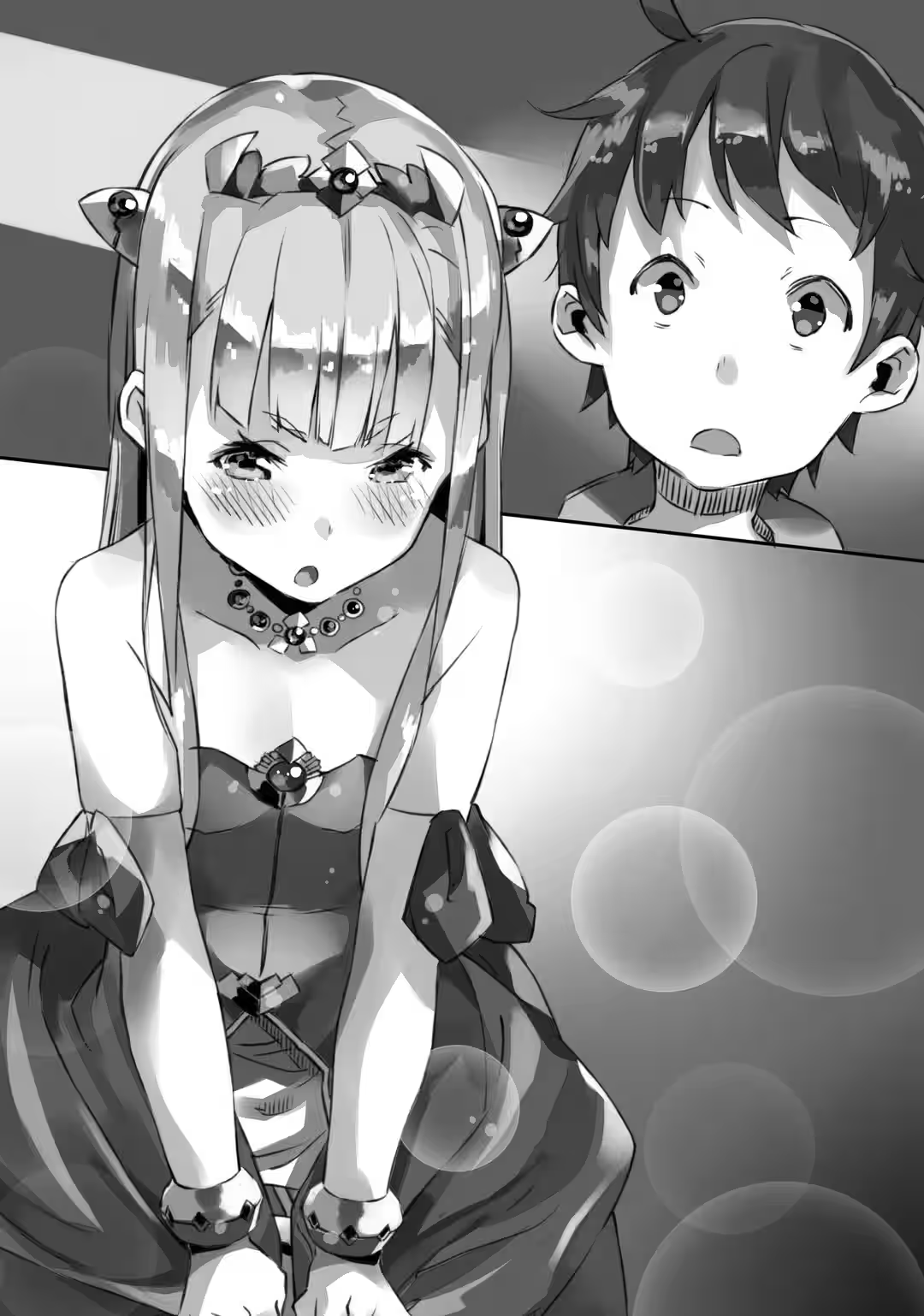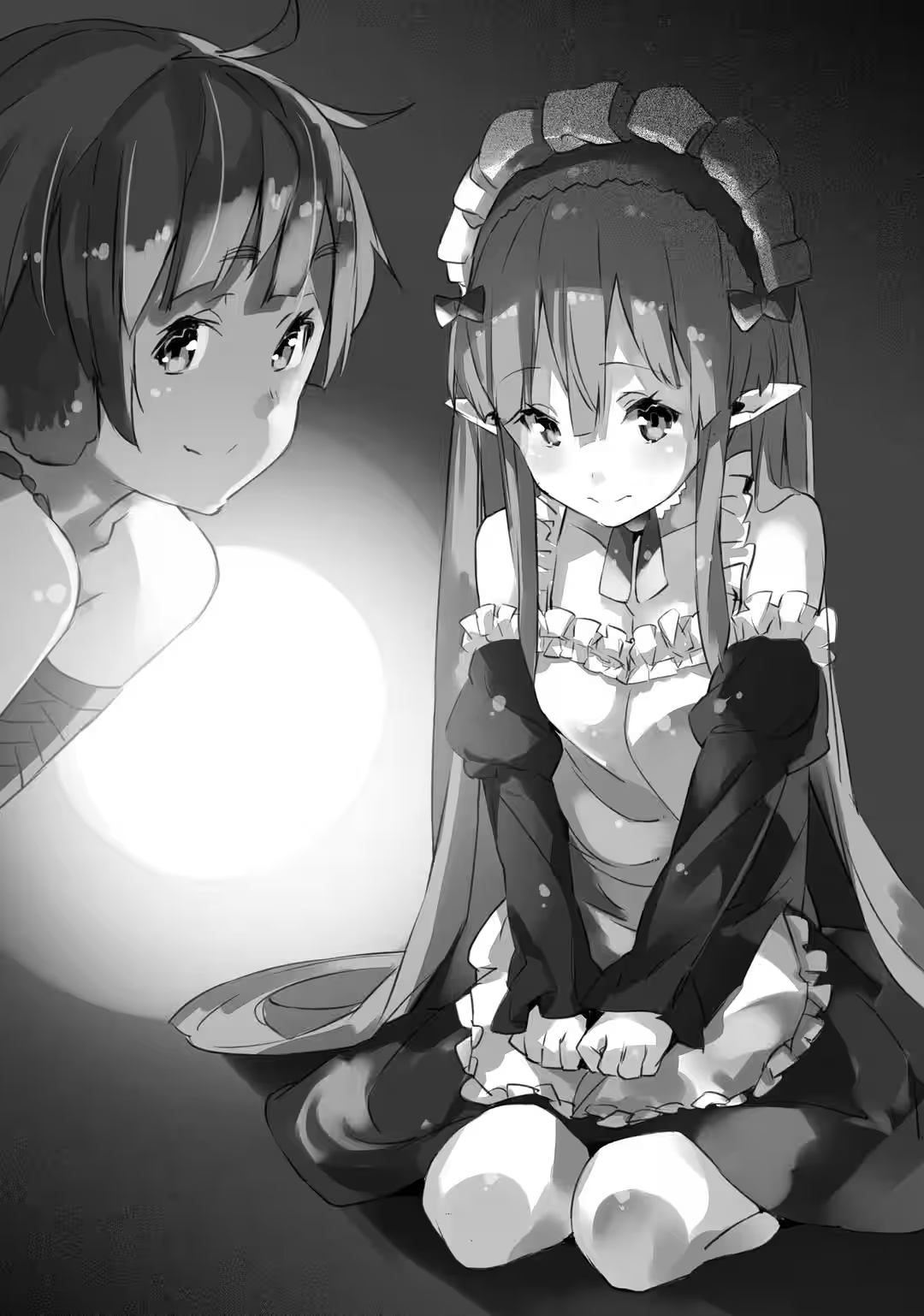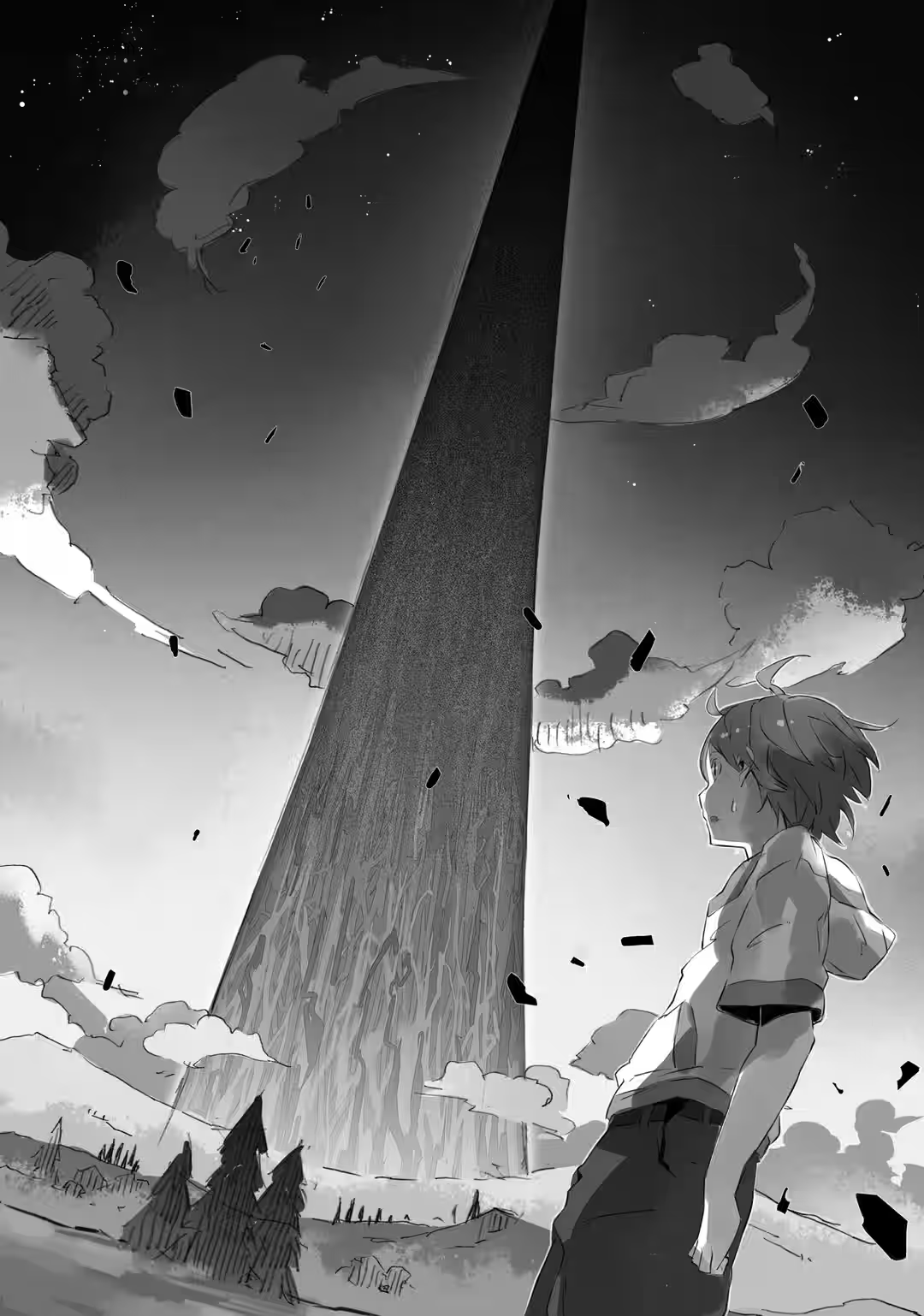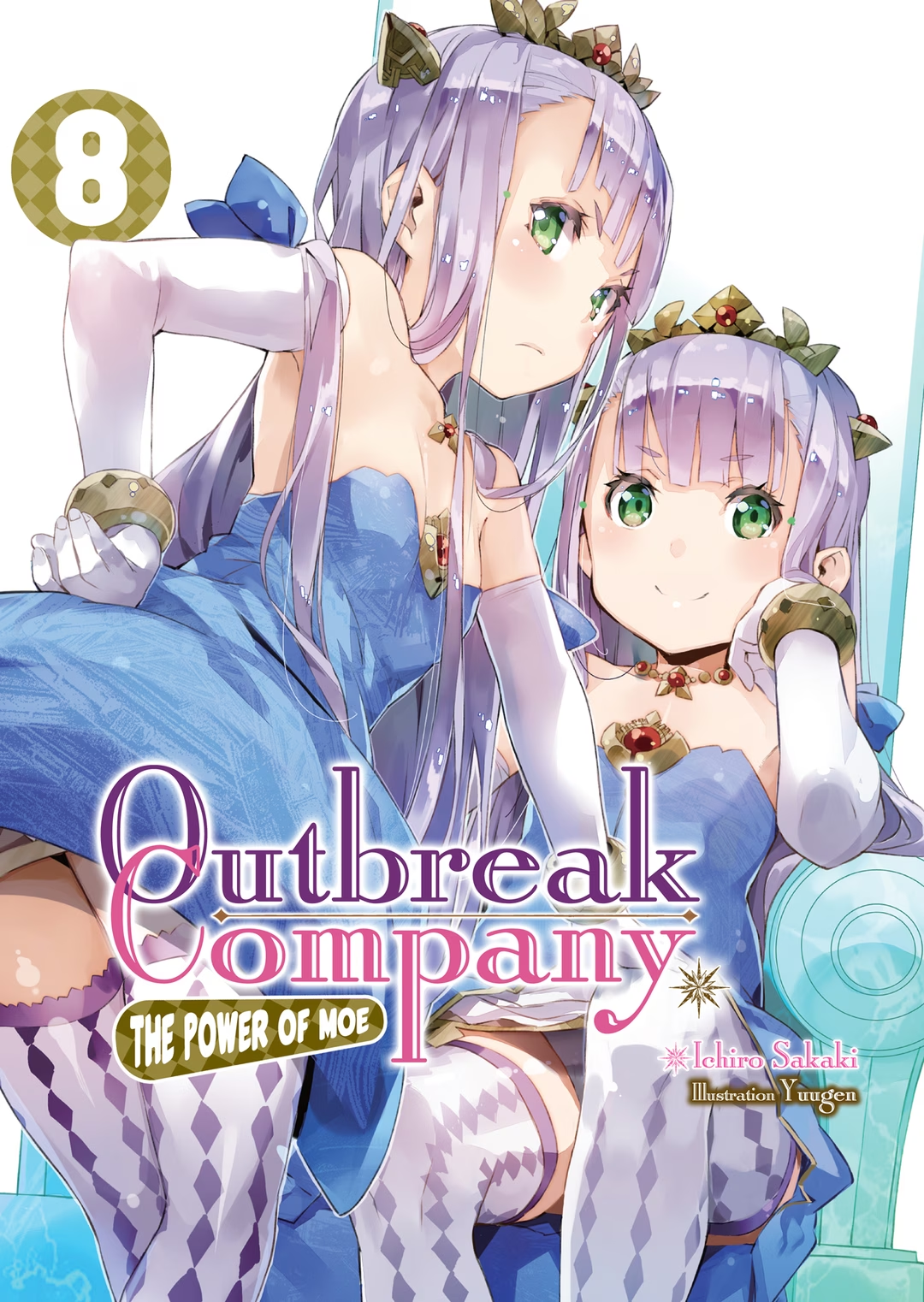

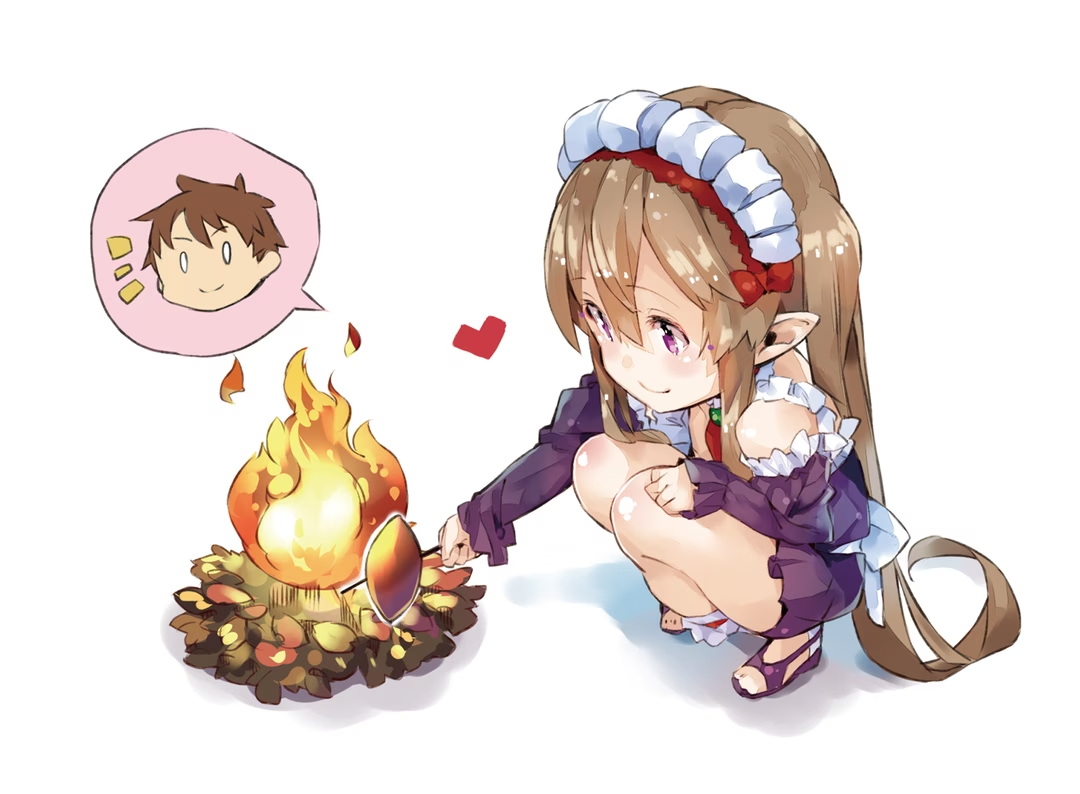

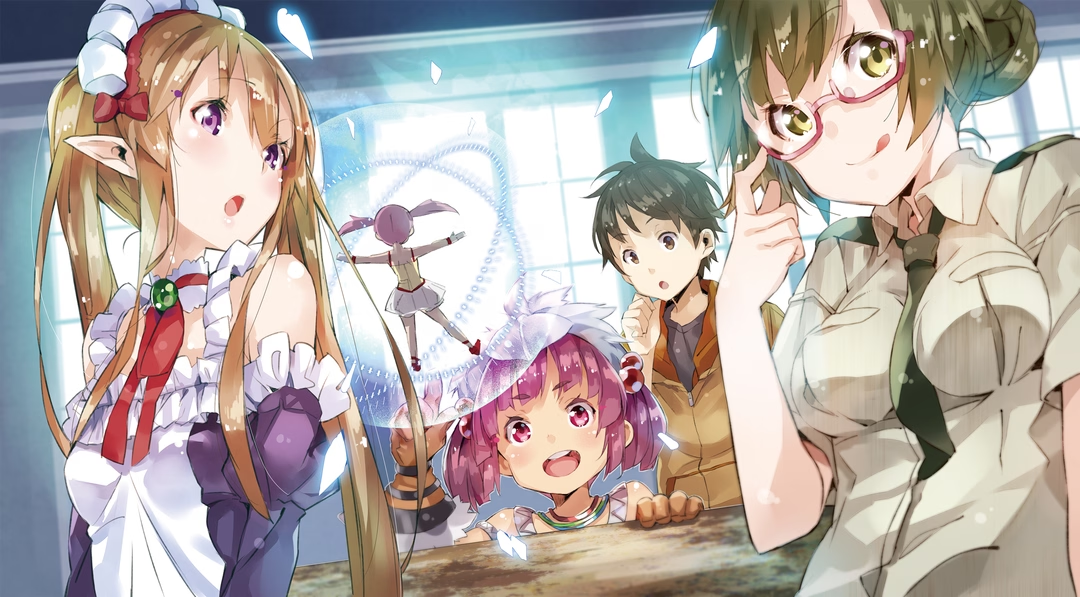
Chapter One: A Royal Replica?
I ran for my life through a murky abyss.
I pumped my legs, dashing as hard as I could. Running was everything.
I had no idea where I was, or what direction I was heading in. Running was absolutely all I knew. Maybe it would have been better just to stand still. But I was terrified by the thought of doing nothing at all.
“Huff... Puff...”
I couldn’t keep this up forever, though. It wasn’t long before I reached my limit. The fatigue was like a weight on my legs, threatening to make me stumble and fall—but I managed to plant my hands against an earthen wall and at least stay upright. I finally decided to stop for a moment. The instant I did so, I broke out in sweat all over.
“Pant... Pant... Uh... RX-78! RX-78 NT-1! RX-79, RX-79 Ez-8, RX-78GP01, RX-78GP02A, RX-78GP03S, RX-178Mk II, MSZ-006, MSZ-010, RX-93v, RX-0, F91...!”
To calm my ragged breathing, I recited the identification numbers of mechs from an anime set in a certain Universal Century. Finally, I had a chance to take in where I was.
I was in a cave... No, more of a tunnel. I was closed in by an overwhelming amount of earth and rock on every side. Obviously I couldn’t see the sky, and there were no windows. Thanks to the lights lining the wall at regular intervals, I wasn’t trapped in total darkness, but they were barely bigger than Christmas tree lights, so it was all relative. The tunnel in front of and behind me faded quickly into darkness, and I could hardly see anything at all.
Where had I come running from? How had I gotten here? I’d already lost track. I did remember, though, several forks in the road on the way.
Yes: this tunnel was practically a maze. And I was in a lot of trouble...
“Maybe this is what it would be like being trapped in an anthill,” I mused by way of escapism. But that quickly led me to imagine giant bugs careering out of the darkness, and I shivered. A massive monster chasing the protagonist through a tunnel is the most stereotyped of stereotypical scenes.
Stop it. You’re jumpy enough just being alone, don’t make it worse on yourself.
You’ve got to calm down, Kanou Shinichi!
I had to chase the frightening thoughts out of my overeager imagination.
I’ve got it. I’ll think about something fun.
Yes! Fantasy. That’s what you need at a time like this.
If I’m going to be chased, maybe it could be by, say, a beautiful girl. “Wait for me, Shinichi-kun!” she’d say as she came tearing after me.
I was pretty impressed with the image in my head. Not to brag, but I’ve been training my imagination for a pretty long time now, and it was capable of some serious feats.
The girl chasing me exclaims, “You’ll never get away again! ♪” and grabs at me. Clutch. Mm, it’s a good feeling. It’s just adorable the way she looks shyly at the ground. The only downside is that then I can’t see the cute little expression on her face.
I bend down, try to get a look.
That’s when she takes the carving knife she was holding behind her back and jams it into my chest, smiling as she looks up and says, “Now we’ll be together forever! ♪”
“Hey, that’s not how it’s supposed to go!” I exclaimed, reining in my rampaging imagination. What was I going to get out of going down the yandere path?
“Eh... I guess it’s not going to do me any good, standing here and playing pretend.”
I heaved a sigh and looked once more into the inky blackness in front of me.
As I said, when you’re lost, it’s usually best just to sit tight and wait for someone to come find you... but I wished I could have waited somewhere a bit less claustrophobic. I decided to keep walking until I found something that wasn’t a constricting tunnel.
I worked my way forward, taking turns pretty much at random. I had nothing but my intuition to guide me—but eventually, the darkness ahead seemed to lift ever so slightly.
It was a light. And not one of the minimal lights along the wall, but something large enough to fill an open space and then leak into the tunnel.
“Yes! An exit!” I exclaimed.
To be fair, I didn’t know whether it was really an exit—whether it led to the surface. But if it at least got me out of this tunnel, that would be a load off my mind.
I burst into the light, grinning with relief and joy.
“Urk...”
The light was stronger than I’d realized; with my eyes used to the darkness, I was almost blinded. I put a hand up to shield my eyes and waited a few seconds for them to adjust.
“Huh...?” I said stupidly.
In front of me was a monster.
It was giant, bizarre. It seemed to be covered in layers of folded steel, like dark-gray armor. It was the size of a small truck and looked awfully heavy. Its back legs were gigantic, and on its front legs grew short but sharp claws.
And were those wings folded on its back?
It had a long neck that culminated in a head covered, like its body, in hard skin. Prominently displayed on the head was a big, serrated mouth, like a crocodile’s.
It was plenty scary, let me tell you. It was just sitting there, like a boulder, but that was more than enough to terrify this onlooker.
“Oh... sh—”
As I stared at it and gibbered inarticulately, it started to move.
It gave one great shake, then its neck stretched out like a snake.
And then—
“There you are!”
“Hagh?!” I screamed when I heard a voice from behind me. A voice that sounded far more cheerful than any voice should have sounded down here.
“We were looking all over for you, Sensei!”
I spun around and saw a diminutive young woman coming up from behind me. Just for a second, I thought she was a child.
But then I recognized her. I ought to—I saw her every day.
She was one of my students.
“Sensei!” she said, looking up at me. “I thought I told you not to go wandering around on your own.” She puffed out her cheeks at me, making her look younger—and cuter—than ever.
She kept her hair cut short (sort of reminding me of a kappa), and the hair ornaments she wore above each ear definitely did look good on her. That is to say, she made a pretty elegant impression—until you noticed the work gloves and boots she was wearing, which looked awfully rough, covered in leather. The overall look said barbarian warrior. I’d seen her holding a halberd before, and while seeing a small person with a big weapon is perfectly common in manga and anime, it was still kind of surreal to witness it in real life.

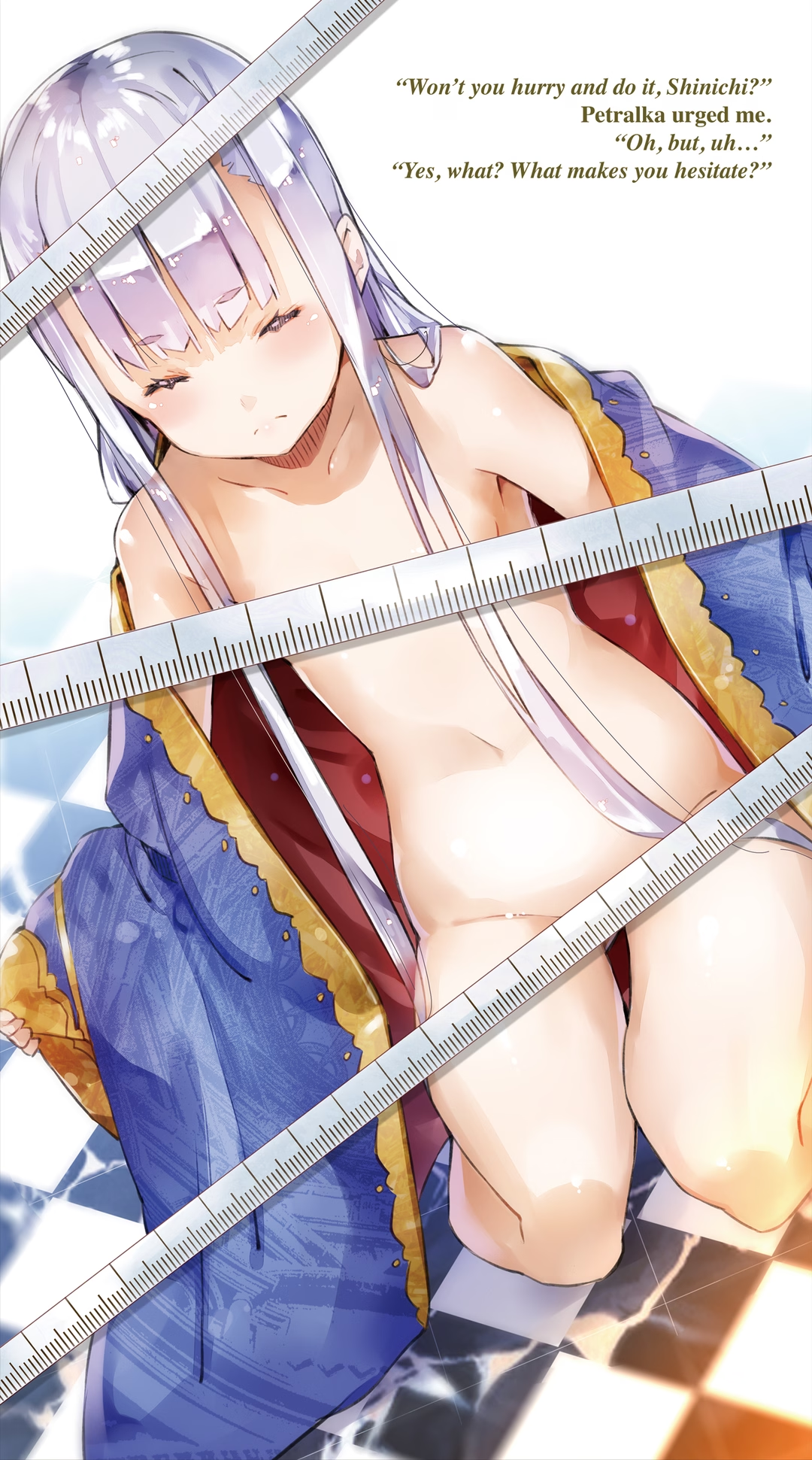
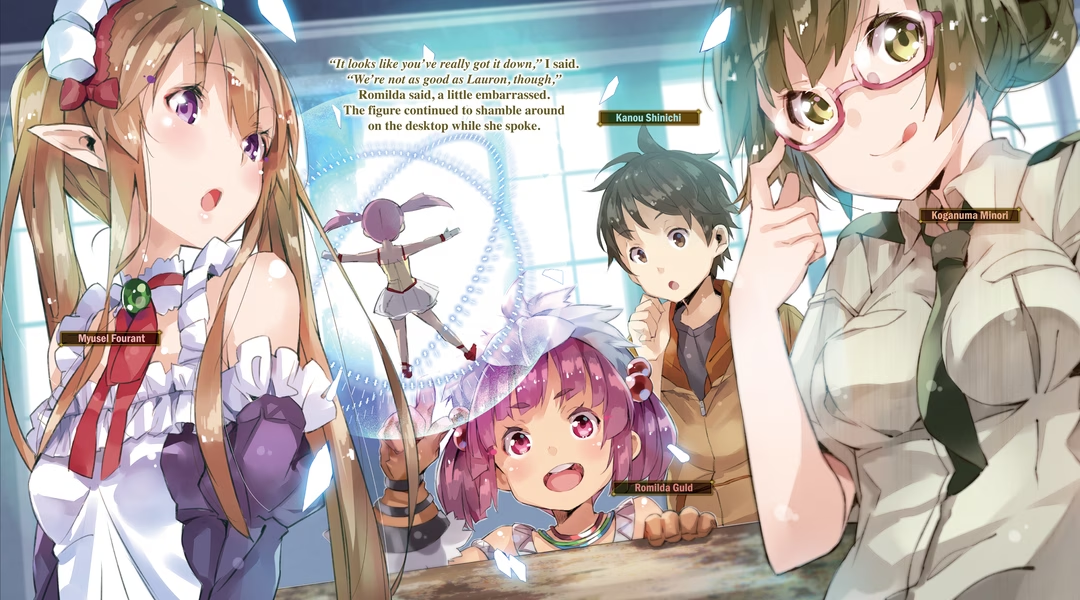
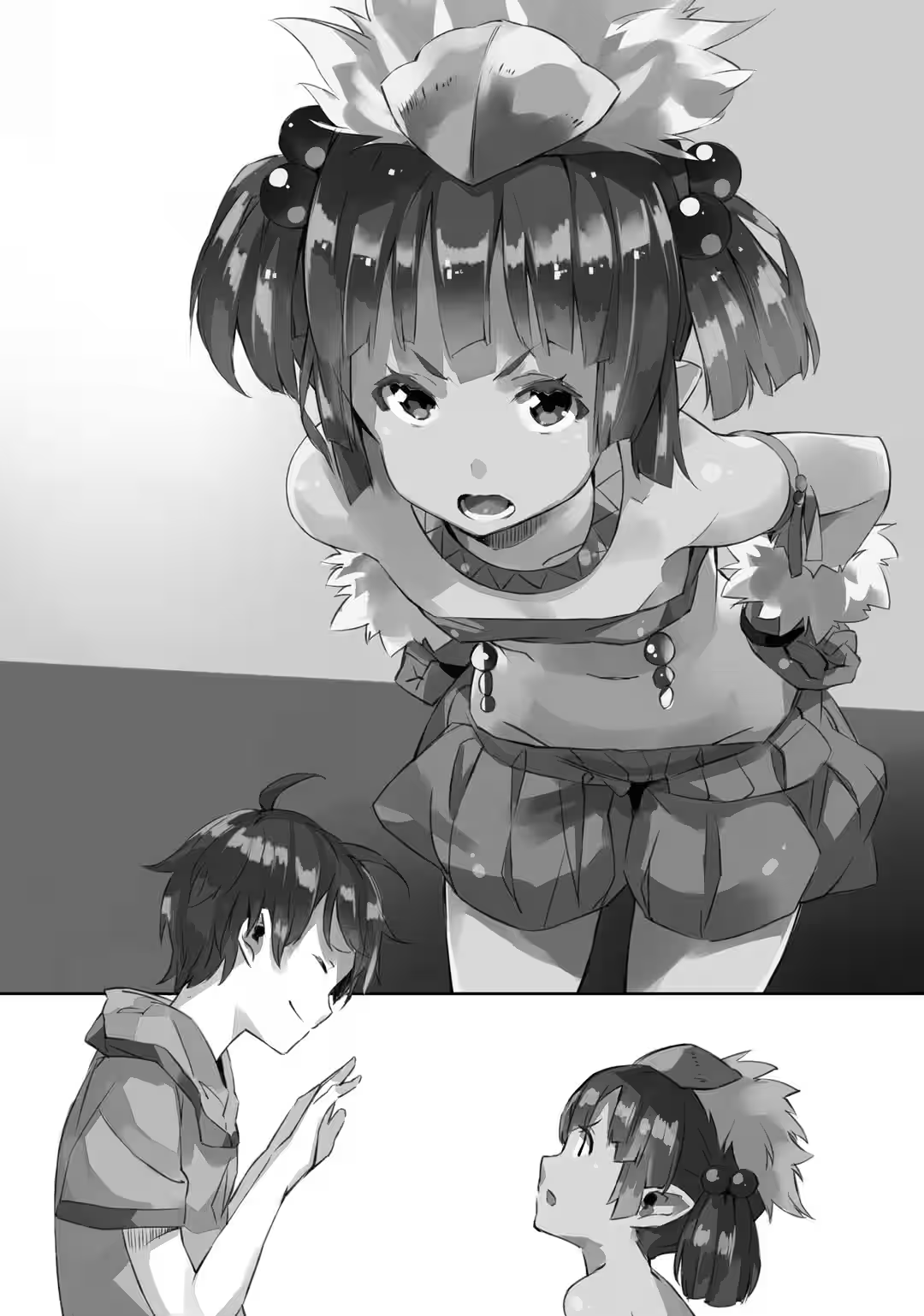
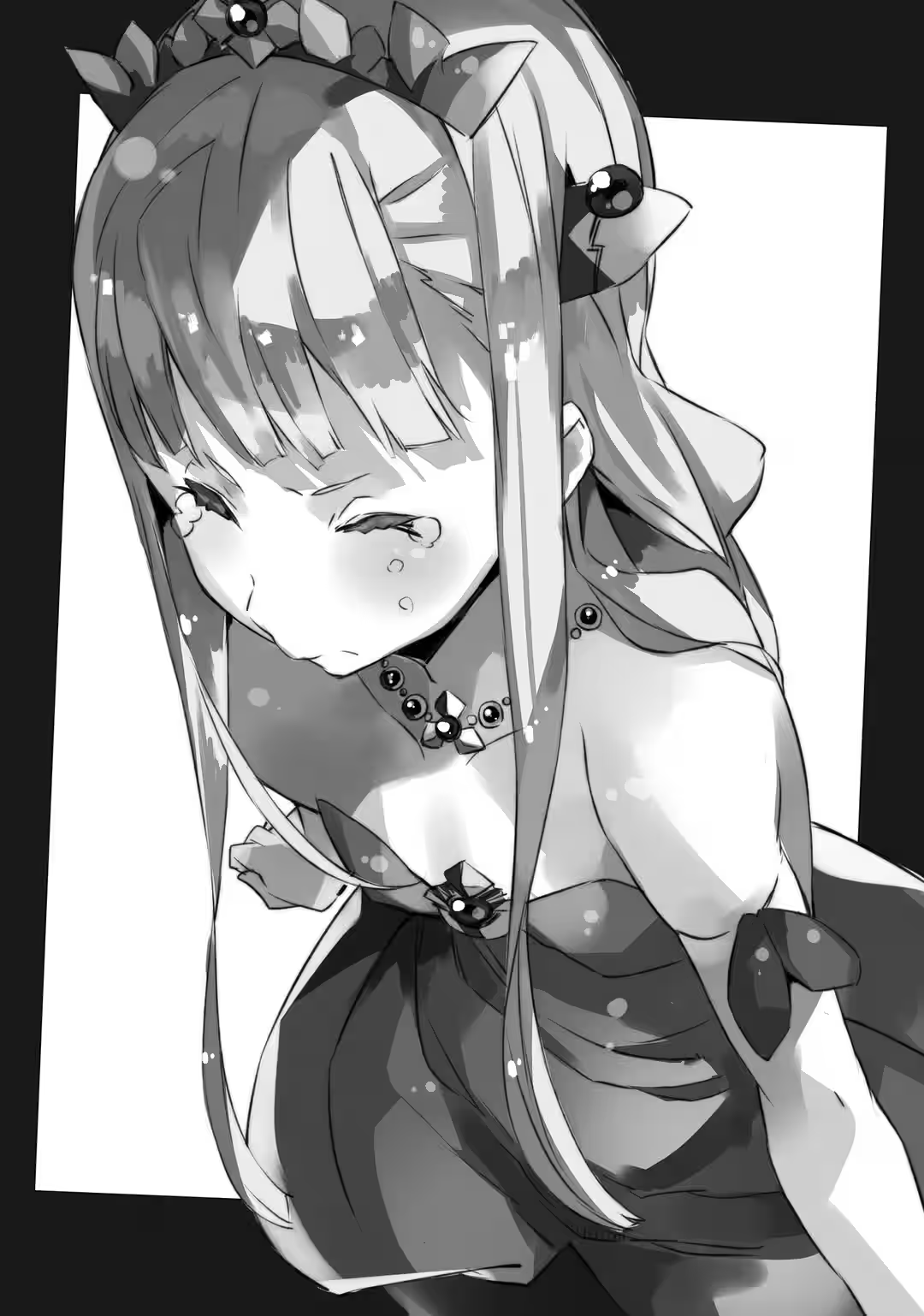
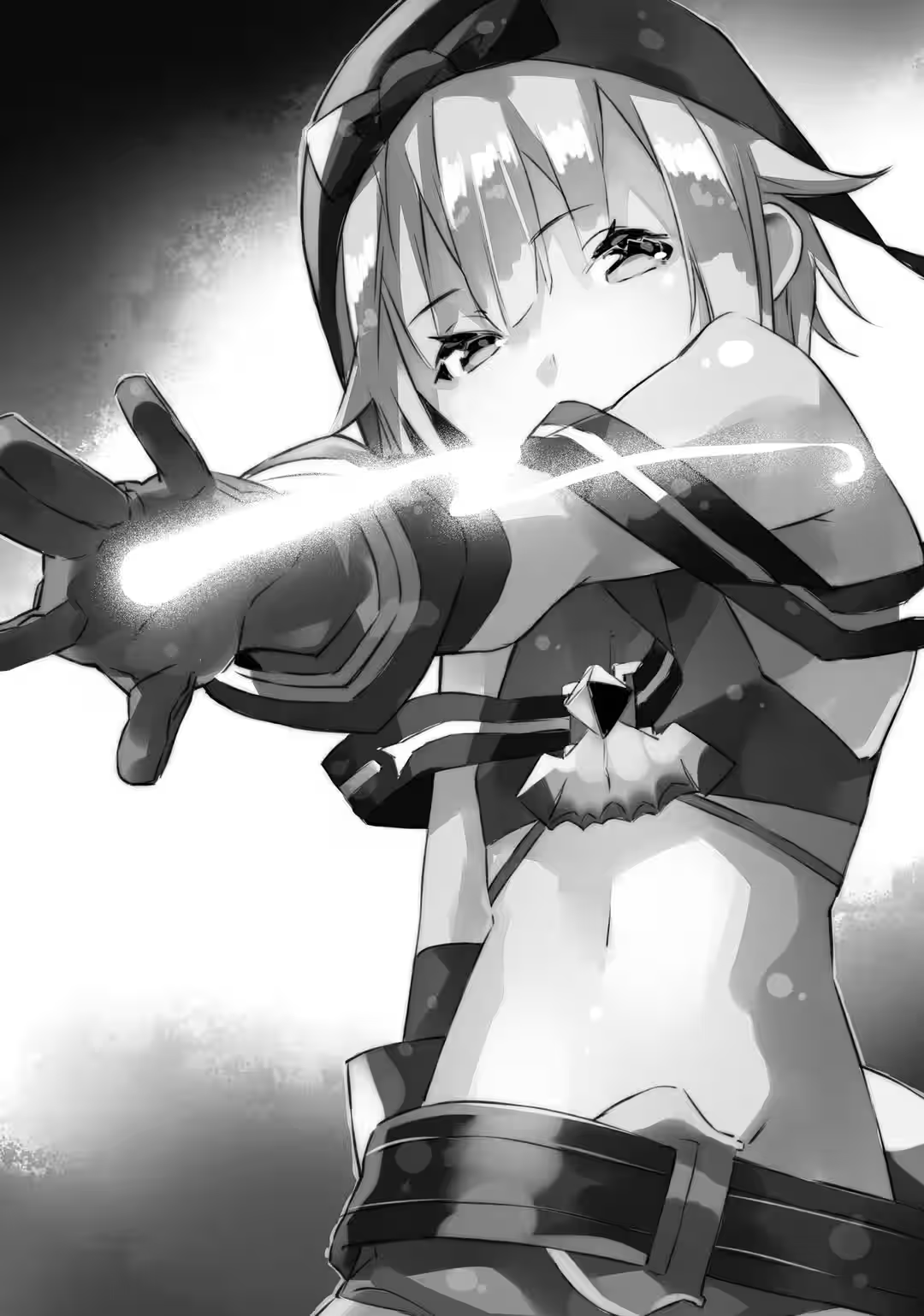
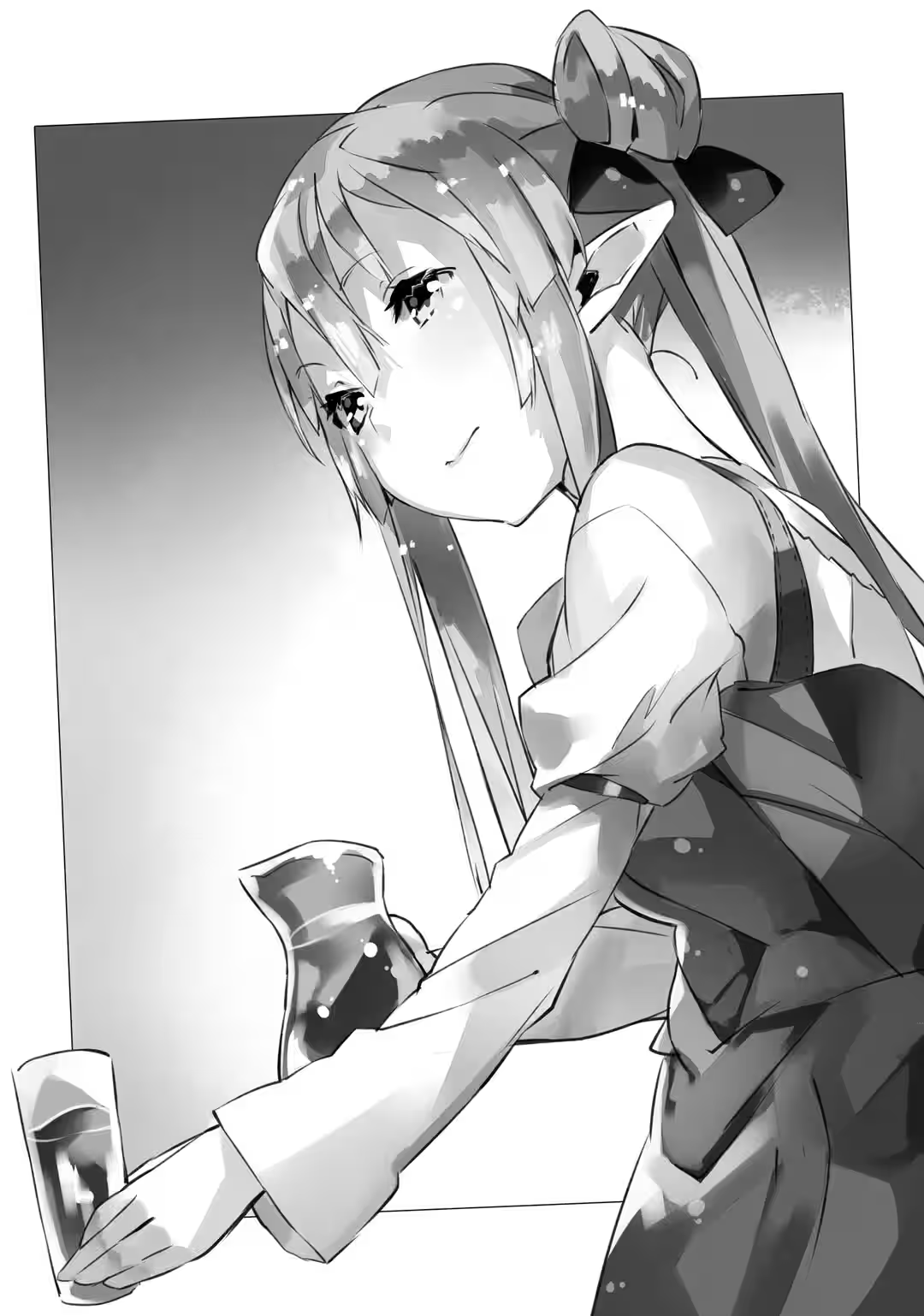
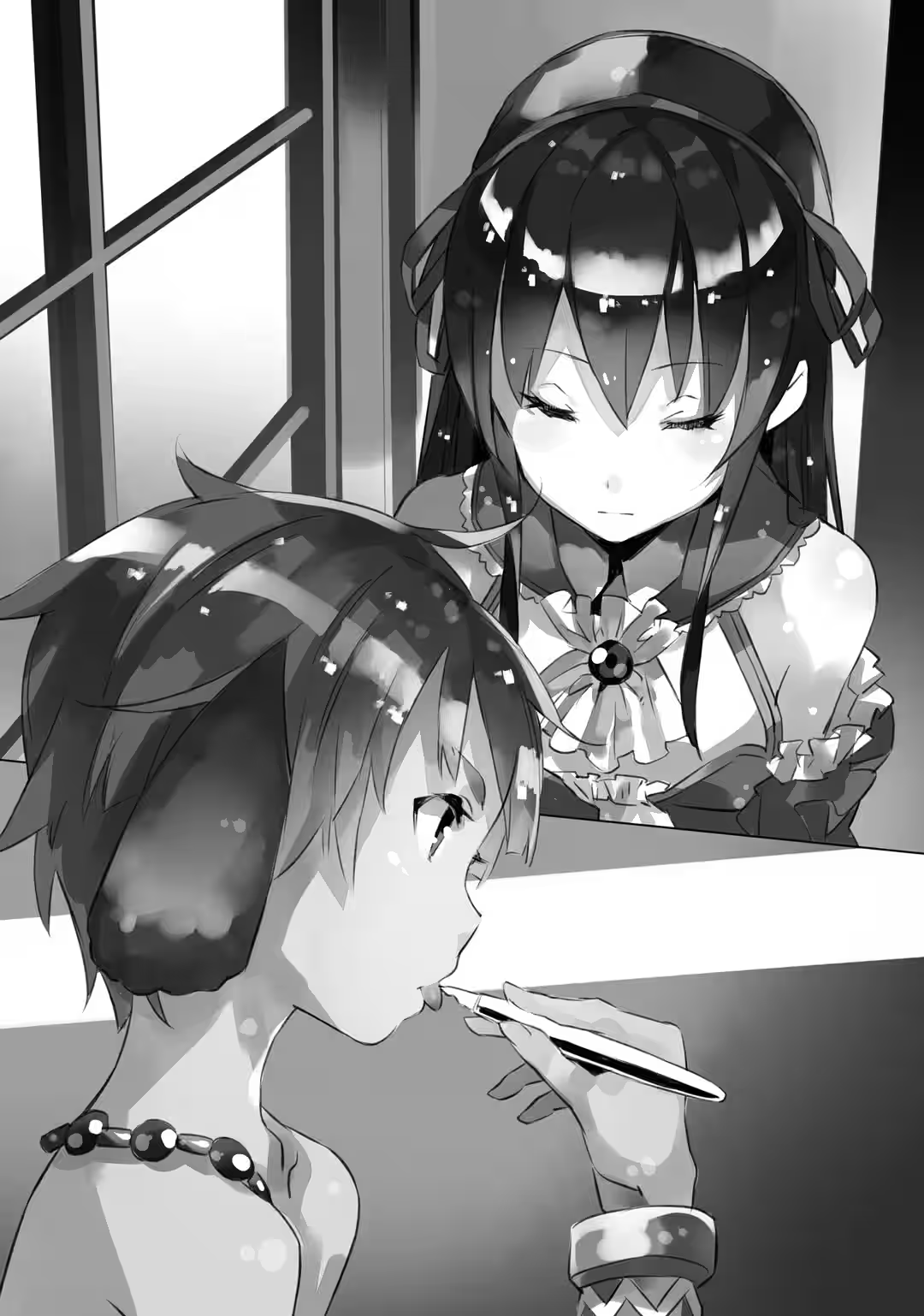
“What...?”
“You never take credit for anything you’ve done.”
“Anything... I’ve done? Wait, I get it.” The lightbulb finally went on about this humility business.
Petralka and Myusel both felt they had changed. And evidently, they were kind enough to chalk that change up to me. That was where all this talk of special powers was coming from.
“Her Majesty must believe that if anyone can help Lauron-san change for the better, it would be you... Just like you’ve done for the rest of us.”
“I really think you’re overestimating me...”
If there was some “power” that had caused everyone to change, I didn’t think it was mine. Maybe more like the power in manga, anime, and games... or something like that. And maybe, at the same time, the power inside of everyone to find something meaningful in those things.
All I did was to offer them up and say, “What do you think?”
I didn’t really feel like I was responsible for any of it—but then, that had been my stance in this world all along. I just focused on the anime and manga and so on; that was my job. The moment I forgot that was the moment I would become a real invader.
That was... To me, that was all there was to it.
But...
“Overestimating? Overestimating?!” Elvia exclaimed. “Me and Big Sis Ama are back to being sisters again!”
“But that...” That really had just happened naturally. I interrupted my own objection, though, and said, “Wait...”
I started to rethink things, just a little.
I definitely wasn’t the only hardcore otaku out there with a sort of low opinion of myself, all too used to being mocked and marginalized by the world at large. I wasn’t the only one it left with a particular kind of weird stubborn streak, an insistence on discounting myself. Like how, if someone said something nice about me, I just wasn’t willing to accept it.
I would assume there had to be an ulterior motive, or tell myself that happiness goeth before the fall.
But what was the point of shooting down every compliment I ever got?
“It really makes me happy to hear that,” I finally said with a bit of a smile. “Thanks.”
Myusel and Elvia looked at each other, briefly speechless.
But then they found their voices and, grinning ear to ear, they chorused, “Of course!”
Chapter Four: Vanishing Magic?
It happened very suddenly.
I was at school, like normal. It was break time, like normal. Everything was just the way it always was. There would have been nothing worth mentioning, except for what came next.
In the classroom, everyone was playing with the magically controlled action figures with which the entire student body (it had gone well beyond the dwarves now) was obsessed.
“I told you, my name isn’t Bunny...” One person was playing with a figure from a certain “buddy hero” anime.
“The only ones you can shoot are the ones who are ready to be shot!” Another was playing with a figure of a character from Order of the Dark Knights: Zero’s Revenge, who saw a lot of use.
“I’m such a fool...” And still another had a Rental☆Madoka character.
They were each playing in their own way, in their own space. The desks became miniature stages for acting out scenes from anime.
Until they weren’t.
To everyone’s shock, and virtually simultaneously, the figures collapsed to the desktops like puppets whose strings had been cut. Clack, clack, clack. They fell over like they had been mowed down by some kind of weapon. Without the magic that had been bringing them to life, they returned to being inert objects.
The students all looked on, dumbfounded.
“Wha...?”
I don’t know who made the first sound of confusion and alarm. Everyone immediately started muttering their spells again, trying to bring the figures back. But none of the characters got up; none even twitched. I guess you wouldn’t normally expect them to—they were toys, after all—but the way they lay like bodies scattered around the room was unsettling.
Even that, though, turned out to be nothing but a foreshock.
“..............................Oh.”
I don’t know who collapsed first, but a number of students went thumping to the floor. It almost looked like they were imitating the figures—like some kind of disease had jumped from the characters to the people.
“What the heck?!
“So sleepy...” Loek muttered, and then down he went—right beside Romilda, who had shoved herself up against the wall but was sliding slowly to the ground.
“Seriously, what?! What in the world is going on here?!” I shouted.
I had seen the figures stop moving before. But the students?!
Hang on... I did remember that when the action figures stopped working, Romilda and the others had been trying not to yawn. Was this somehow related?
“Sensei?!”
Some of the students looked at me, panicked, but I was even more confused than they were and didn’t know what to do.
“What in the heck...?”
Some students were down, yes. But others seemed unaffected. And the difference between the two groups was...
“It’s only the elves and dwarves?!”
Yep. Only the elves and the dwarves were going unconscious. The human students in the classroom were all in perfectly normal condition, while the elves and dwarves took a collective nap.
But that meant...
“Myusel?!”
With a start, I turned toward the faithful maid who was at my side even here in the classroom.
I couldn’t get a word out of her.
“Myusel!”
When I called her name a second time, she flinched a little and her eyes drifted open. She looked deeply fatigued, though, and her whole body was limp.
It looked like the Sandman was really on a rampage...
“What’s wrong, Myusel?”
“I’m... sorry, Master.” She shook her head. “I’m just so... sleepy.”
“Sleepy? What do you mean, sl—”
Why so suddenly? Did it have something to do with why the students couldn’t use magic anymore?!
“Sensei—”
“My magic...”
Students called out to me plaintively. None of their magic was working. Some of them were apparently trying to use spells to revive their collapsed classmates, but they weren’t getting anything out of it. It didn’t seem to be that the spells weren’t having any effect, so much as that the magic itself didn’t even function.
Was this—
what Petralka was talking about...?
Localized fluctuations in magic? A deficit of magical power?
“No way...”
I could feel my heart starting to race with panic.
Magic was to this world something like electricity was to ours. People just took it for granted; it supported everything they did in their lives. Suppose all the electricity suddenly disappeared for no reason we could discover—imagine what would happen.
Had the elves and dwarves collapsed because of something to do with the missing magic? And if they had...
A shout sounded in the buzzing classroom. “What is that?!”
Several students were looking out the window and pointing. I looked out, too...
...and took the world’s biggest gulp.
A dark, round pillar stood there. It stretched up into the sky as if connecting heaven and earth, dividing the world in two, a great, black streak. I couldn’t tell how far away it was, but one thing was for sure: it was big, big, big.
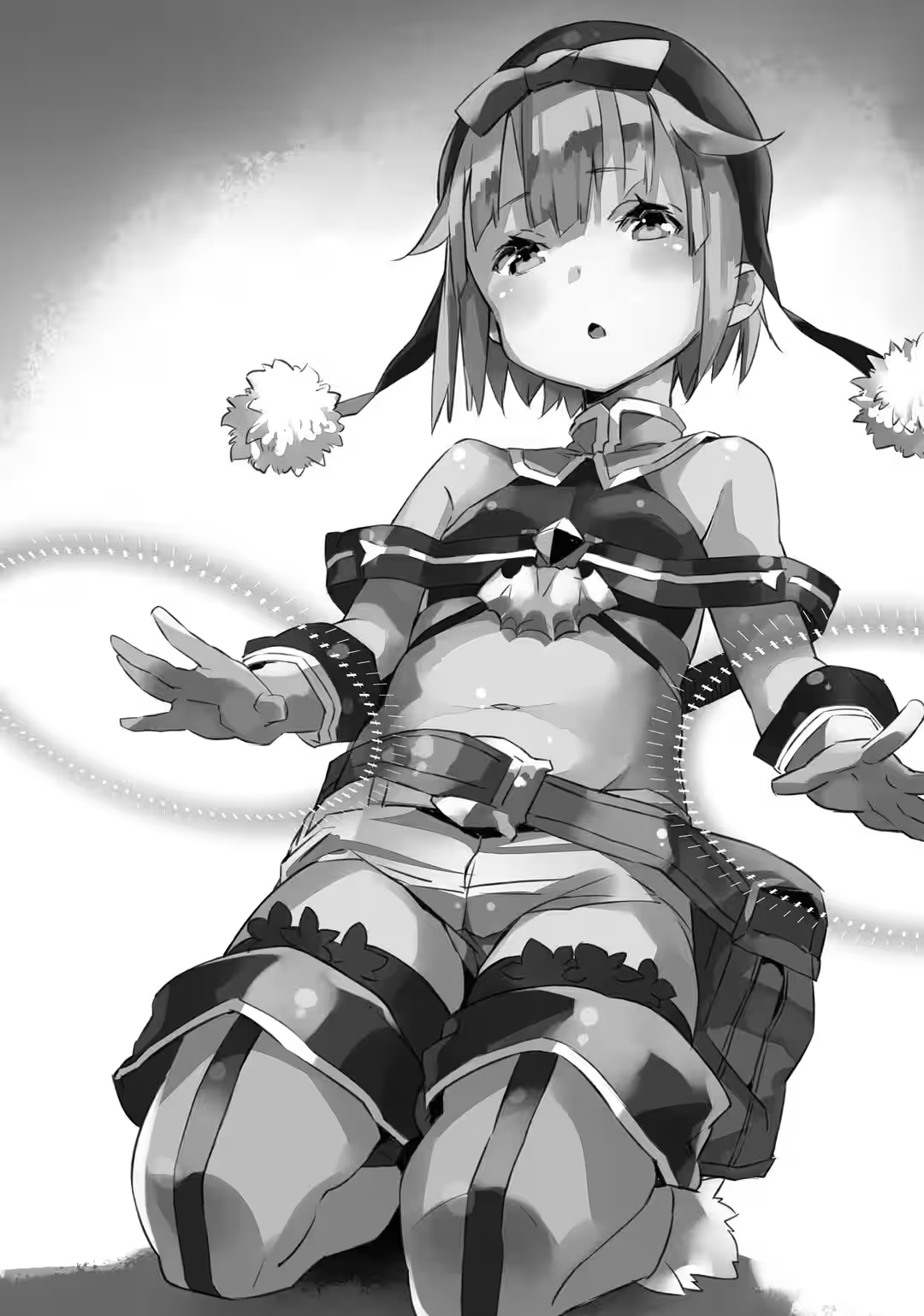

Afterword
Hullo! Light novelist Sakaki here, bringing you Volume 8 of Outbreak Company: The Power of Moe.
Petralka’s on the cover this time. Twice! (How’s that work?) She hasn’t had a good way to take a very active role in the last few volumes’ stories, so I’m trying to set things up here with an eye for the future. And look where we find ourselves (reference the illustrations)!
It was just before a certain broadcast on Nico Live. Three of us (myself, the illustrator, and the editor) were having a conference at a certain family restaurant.
“Ahem. There seems to be a distinct lack of Myusel in this volume. Do you think that’s okay?” (says editor-san.)
“I really think it’s going to be fine,” my dear illustrator Yuugen-san broke in. I’m pretty sure I can see what he means now. I think.
And then there’s the anime. Yes, the anime!
As I write this (October 2013), the first episode of the series has aired, with the second coming up soon. Being, technically, part of the creative staff, I’ve already had the privilege of seeing episode two in the blanks (the video files sent to the people involved prior to broadcast), and the director’s personal style is abundantly in evidence.
Outbreak Company doesn’t really have big fight scenes in every volume; dramatic conversation is one of the series’ selling points. But that’s actually tough to pull off in an anime. The director, the sound designer, the actors—all these people’s sensibilities have a major influence on the final product, so it can be tricky to create something coherent. I get the impression, though, that the anime strikes a good balance with the character dialogue.
By the way, on the subject of Petralka, the final moments of episode 1, where Shinichi takes a royal uppercut, are well-animated and adorable (Yuugen-shi also recommends them), so if you haven’t seen it, then please, by all means. Listen carefully and you’ll hear some wild ad-libbing by Fuchigami-san, too... (grin)
The actual content is what it is, but we’ve tried to screw around with things a little. Keep your eyes peeled as you watch. There was one particular scene where Shinichi starts chanting “Nou-kan! Nou-kan!” and because I hadn’t seen the anime of that specific series, I actually didn’t know what he was referring to. I was sitting there thinking, What?!
Miki Shinichirou-shi’s work as Garius in episode 4 is completely nuts—I mean that in the best possible way—and you’ve got to check it out. An assistant on Outbreak Company and I happened to get to attend a looping session for that episode, and Kajiya Kiri-san, who does the manga, was there too. The three of us were standing there in the studio listening to “MikiShin” and trying to laugh as quietly as we possibly could.
This is actually the third time I’ve worked with Miki-san—and both other times he was the main character of the series in question. So I came into this one thinking, Is it okay to make the Miki Shinichirou play a side character like this? But he showed me what it means to be a veteran, someone who doesn’t sniff at any character he gets to play (laugh).
Actually, there are enough familiar faces involved in making Outbreak that sometimes I have to stop and remind myself which show we’re working on.
Let’s see here. I worked with the producers (feel.) and the sound designer on Strait Jacket. Pony Canyon produced Shinkyoku Soukai Polyphonica. I already mentioned Miki-san, whom I worked with on Strait Jacket and Scrapped Princess.
Somehow this is all very strange.
Speaking of the anime, I’ve been charged with doing a special short story, as well as the script for a drama CD that will accompany Volume 9. Both of them, especially the drama CD, feature the sorts of wildly overdone plots that you can only do in anime, or at least that you definitely can’t get away with in the main series. So, uh, hope you like?
Okay, then. That’s enough anime talk; let’s move on to the book. Spoilers follow, so if you haven’t finished the story yet, you may want to go back and do that.
Volume 8... the otaku hook here has to do with action figures or dolls (remember that the Japanese word for “doll” and “puppet” is the same). I imagined the moving figures as looking a bit like something produced by MMD Software—you know, the thing that gives us Hatsune Miku.
Only beginners and the uninitiated assume that because something is in 3D, you can make it look real just by having it move. There are real differences between how a living thing moves and how a lifeless thing trying to imitate a living thing needs to move—it’s a fake, right? So it has to look more real than real; you need this sort of X factor.
I’m thinking this is sort of like the realism of the novels and images I allude to on Twitter and in my books.
Just as a note, there are some details in this book that contradict what’s in the anime and manga versions. (Stuff like how Imarufe Bisurupeguze is handled, the connection between sprite-like beings and magical energy, and so on.) That’s on me—or more to the point, I didn’t write the plot for this volume until after the plot for the anime and the rough panel layout for the manga were already finished. So I was behind the curve and ended up contradicting the other versions.
I’m very sorry to all my no-doubt-concerned readers and supporters.
Still, each of the versions is internally consistent, so if you could just smile and wink, that would be great.
So, what’s coming up next?
I’ve got the plot for Volumes 9 and 10 in hand (submitted to and approved by my editor). They’ll essentially form a two-parter, and they’ll feature a character (?) that readers have been very interested in. At last. Although I’m not promising this character will necessarily get the limelight or anything.
As for the actual story, it’s something I think a lot of you have been anticipating for quite a while. You know.
Hope you like it.
Welp, see you next time.
Ichiro Sakaki
9 Oct 2013
Bonus Translator’s Notes
Chapter One
Universal Century
The mech identification codes are all Gundam references.
Yandere
A yandere is a girl who is loving and sweet until it turns out she’s actually possessive and crazy. The specific scene in this volume appears to reference Mirai Nikki (Future Diary).
Kappa
A Japanese water demon. Its head has a depression on top filled with water; if you can trick the kappa into bowing, the water will pour out and the monster won’t be able to move. They are also usually depicted with short, bowl-style haircuts, which is the detail Shinichi has in mind here.
“A Kawaii-ness All its Own”
In Japanese, Shinichi uses the word kyuuto (cute) in katakana, so we figured turnabout was fair play.
Cross-Dresser
Jp. otoko no ko. When written with the characters for “male child,” the phrase otoko no ko simply means “boy.” However, some Japanese cross-dressers replace the character “child” (ko) with a different one meaning “daughter” or “girl” (also pronounced ko) as a play on words.
Cour
While Western TV series are usually divided into “seasons,” and the term is sometimes informally used to refer to sets of episodes of an anime series, the technical term “cour” (apparently derived from the French word for “course”) is more precise. A cour is usually thirteen episodes.
Weapons Systems Don’t Have Jugulars
The Japanese expression, mi mo futa mo nai, literally means “to have no body [i.e., container] and no lid,” and idiomatically means “point-blank,” “blunt.” So Shinichi accuses Minori’s declaration of being mi mo futa mo nai (too blunt), to which Minori replies that weapons systems have no containers (mi) or lids (futa).
About to Attack
The reference is to Attack on Titan, which is called Shingeki no Kyojin (literally, “Attacking Titan”) in Japanese. Shinichi suggests that the robot might be about to “shingeki” (assault, attack). This makes the Japanese allusion perhaps a bit more clear than the English one; we compensated by using the word “titan” in the next sentence.
Ult**man
That is, Ultraman. This character’s face is clearly humanoid, but lacks much in the way of facial features, which is the point at issue.
Lauron Selioz
Jp. Roron Seriozu. The Japanese sound usually romanized with an r is really somewhere between an r and an l, and when to use one letter or the other when localizing a character’s name can be a thorny problem. In this case, we took the name as being akin to “Lauren” and romanized accordingly.
Garaham
Jp. Garahamu. Sounds much like the English/Germanic name Graham—which means “gravel” in its oldest form.
Elementary-Schooler Backpacks
Elementary-schoolers (shougakusei) in Japan all wear distinctive red backpacks.
Otome Game
A visual novel aimed at women (that is, most of the romantic prospects are guys).
Boys Over Flowers
We very rarely take it upon ourselves to insert references that aren’t in the original, but in this case we took the liberty. This reference actually ends up being a bit dizzying to contemplate. The original expression hana yori dango (“Dango [rice balls] over flowers”) means to prefer the practical to the merely aesthetic; the manga series of the same name punned on the expression to mean “Boys over flowers,” and now we’re using the English translation of the Japanese pun in the manga title with the understanding that “flowers” means girls. But we kind of love it for that.
Kagemusha
Literally “shadow warrior,” this term refers to a body double employed by a feudal daimyo, as Shinichi suggests. Like he hints, it’s also the title of a well-known movie by Kurosawa Akira.
Isukiri
A particular town in Aomori (a prefecture in northern Honshu) contains a tombstone alleged to be the burial place of Jesus Christ. Historically, people in the area have believed in the legend Shinichi describes: that it wasn’t Jesus who died on the cross, but his younger brother Isukiri (a name transparently derived from Iesu Kirisuto, the Japanese equivalent of “Jesus Christ”). Jesus himself escaped through Siberia and wound up in Aomori, where he lived out the rest of his life.
Teachers’ Room
That is, the shokuinshitsu (staff room). Every Japanese school has one of these, so although it hasn’t really been mentioned before, it makes sense that Shinichi’s school, which is explicitly built on the Japanese model, has one as well. Each teacher at the school has a desk in the staff room where they can keep their papers and supplies and prepare for lessons. Teachers can generally be found in the staff room when not teaching; students may be summoned to the staff room to see a teacher or may go there of their own volition if they need something from a particular sensei.
Fig*a
That is, Figma, a brand of Japanese figures renowned for its highly articulated models.
Mike-mike Osuwari
Most likely a reference to Minami-ke Okawari, the second season of the anime Minami-ke. The show was about a family named the Minamis (the word minami means “south”), and the character Shinichi refers to has the surname Kita, which means “north.” (“Okawari” means “seconds,” whereas “osuwari” means “sit!”, as in a command you would give a dog.)
Faerie Field
This is a fun one: フェアリー・フィールド (Fearii Fiirudo), featuring a character named Serris, is a light novel (not a video game) by... Sakaki Ichiro. In the Japanese here, he’s “changed” the name by rendering it as フェアリイ・フィールド, handling the final vowel of the first word with a second i character instead of a long-vowel dash. There’s no official English version of this series, but we thought it would be more likely to be called Fairy Field, so we similarly changed the (hypothetical) spelling of the first word somewhat.
A Certain Such-and-Such Savior Legend
This is a Fist of the North Star reference. It seems to allude to the video game Hokuto no Ken Seiki-matsu Kyuuseishu Densetsu (Fist of the North Star: Turn-of-the-Century Savior Legend).
The Epic of a Certain Meiji-era Swordsman
This is a reference to Rurouni Kenshin, which had the subtitle 明治剣客浪漫譚 (Meiji Kenkaku Roman-tan) or “Romantic Tales of a Meiji Swordsman” in Japanese. (The elaborate subtitle doesn’t seem to have been carried over in the English release of the manga.) There’s a sequence late in the manga (spoiler alert—it wasn’t in the anime) where Kaoru is killed—but it later transpires that the thing Kenshin saw “die” was actually an elaborate doll, and Kaoru is okay.
Kurobe Dam
An actual dam in Japan that is a popular tourist destination. It doesn’t appear to have any currency as a pop-culture metaphor, so it seems Shinichi is only referencing it because it’s well known.
“It—It Gets Lonely, Does It Not?”
In Japanese Petralka says simply, “Sa—Sabishii, dewa nai ka” (“L-Lonely, no?”). Because an explicit subject isn’t usually necessary in Japanese, she can leave it artfully ambiguous who she’s talking about. She might be referring to herself—but then, maybe she’s talking about Shinichi, or even just a general atmosphere.
Bittersweetness
Amazuppai (bittersweet) can refer to a flavor, but also means the sweet-but-also-bitter pangs of adolescent love.
Chapter Two
Prepure
A reference to the Precure franchise and a show that Shinichi has mentioned before.
A Passionately Celebrated Hero
Shinichi describes Brooke as an “atsui” rizaadoman no eiyuu (“hot” lizardman hero); atsui here, considering the highlight quotes, is probably an incidental pun on lizards being cold-blooded. (In Japanese, the word atsui, or “hot,” can be used to mean “passionate” or what we might call, ironically, “hot-blooded.”)
Slutty Bottom
Jp. sasoi-uke, that is, an uke who takes the initiative in beginning a sexual encounter (the Japanese literally means “inviting bottom”). There doesn’t seem to be an equivalent English expression, and although the Japanese term has some currency in English fandom, in this scene it’s specifically being contrasted with sou-uke (total bottom), which we translated when it appeared in Minori’s lesson many volumes ago, so we wanted to maintain the English usage.
The Ending Song from Prepure
The Precure anime has something of a tradition of ending sequences that use CGI to create convincing renditions of the animated characters doing song-and-dance routines. It’s easy enough to find clips and compilations of them on YouTube if you want to see the sort of thing Lauron is probably watching.
Overwork
The Japanese term karoushi literally means “death from overwork,” and that’s what it describes: someone who has worked so hard that they reach their physical limit and die (such as from a heart attack or stroke). In Japan, it’s especially associated with the bubble economy of the 1980s, when many office workers kept absurdly long hours; however, it remains an issue today in Japan’s work-conscious society.
Magical Rampage
Jp. mahou no bousou. This expression is associated with the Dragon Quest games, and refers to a random phenomenon where a spell will be more powerful than normal when used.
Yodeling in the Alps
A reference to the 1974 anime Arupusu no Shoujo Haiji, or Heidi, Girl of the Alps. Notably, the series was directed by Studio Ghibli founder Takahata Isao.
“Dutch Wi—”
I.e., Dutch wife, in this case, a body pillow or sex doll. The reference to “the passenger seats of cars” relates to how some people allegedly use inflatable dolls to make it look like there are more passengers in their cars than there really are, allowing them to use the quicker carpool lanes to avoid rush-hour traffic.
Minori’s Posture
The way Minori leans on the table with her fingers steepled in front of her face is a direct reference to a posture frequently adopted by Ikari Gendou in Neon Genesis Evangelion. The narration and dialogue that follow both contain multiple allusions to the same show.
Chapter Three
Japan’s Educational System
Education in Japan often relies on a good deal of rote memorization—something that’s hard to avoid when your written language consists of thousands of distinct characters, but which can (critics allege) stifle the development of independent creative thought when extended to the rest of the curriculum. That’s the criticism Hikaru is alluding to in this discussion: the focus on memorization over understanding.
Goethe or Heine
Johann Goethe (1749–1832) was a German writer and thinker whose work encompassed a dizzying variety of fields and subjects. Heinrich Heine (1797–1856) was a poet, among other things, who leveled a good deal of sarcasm at the romantic movement that gripped poetry around the time of his life.
We Have No Choice but to Die!
A line from Madoka Magica. In Japan, the line (“Shinu shika nai ja nai!”) became the basis for a number of memes.
More Yan- than -Dere
Again, a yandere is an archetypical character (usually a girl) in anime, who is in love with the main character (that’s the -dere part), but also has a tendency to inflict severe physical violence on him (that’s the yan-).
Disaster Relief
As we’ve noted in the past, the Japan Self-Defense Force is very limited in the specifically military activities it’s allowed to undertake. Peaceful operations, however, are allowed, and the JSDF is frequently deployed in response to natural disasters, somewhat in the way the Coast Guard is used in the US.
Auto-Changer
In Japanese, the power is called jidou shokubai (auto-catalyst), and glossed with the katakana ooto cheinjaa.
Chapter Four
“My Name Isn’t Bunny...”
The reference is to Tiger & Bunny, which is frequently characterized as a “buddy hero (baddii hiiro) action” show on the Japanese internet.
The Sandman
The Japanese version of the Sandman is the suima (睡魔), composed of the character for sleep and the character denoting a magical being. In Japanese Shinichi literally says Myusel seemed to be “fighting an especially vicious suima/sleep spirit.”
Bombing Hurricanes
This is something that has actually been proposed in the past as a way of averting especially bad storms. As Shinichi remarks, though, a hurricane simply contains too much energy for it to be neutralized by any reasonable amount of weaponry. (That’s not even to mention the potential problem of fallout when using nuclear bombs.)
What Do You Want to Do?
This entire line comes from an episode of Gundam Unicorn.
Byar**nt Custom
The Byarlant Custom, a powerful Mobile Suit from the same series.
110mm LAM
LAM is short for Loitering Attack Munition, a system in which the weapon (such as a drone) stays in one area (that is, loiters) until it finds a suitable target, which it then attacks. As Shinichi says, this was also referenced during the sequence in Bahairam in Volume 5.
People Seem to Get Stronger During a Crisis
Just as a point of interest, the Japanese for this is kajiba no baka-jikara, literally “outrageous strength at the scene of a fire.” The image is of someone doing something extraordinary in the face of a raging inferno, equivalent to the proverbial mom lifting a car off her child.
Atmospheric Lid
空気の蓋 (kuuki no futa, “air lid”) in Japanese. This appears to be an invented term. Perhaps it involves the toilet mages creating a wind phenomenon that prevents sprites from escaping.
Afterword
Nou-kan! Nou-kan!
A reference to the anime version of the series Tobaku Mokushiroku Kaiji, a story about gamblers which we’ve encountered in these notes before.
